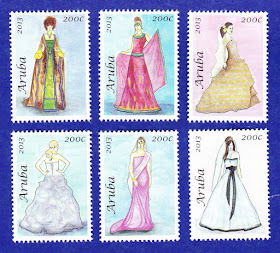Designed by: Stan Kuiperi
90c: Celebrations - Dera Gai (Bury the Rooster)
This stamp represents one of the main celebrations of Aruban culture, the Dia di San Juan (Saint John the Baptist Day) on June 24. An ancient pagan native harvest celebration, it was allowed to continue by the Catholic missionaries who combined it with the Roman Catholic calendar to coincide with Saint John’s Day.
Over the centuries, the Saint John’s Day celebration on Aruba developed in a unique way. Farmers would save harvest material and would burn this ceremoniously on the eve of June 24 and on Saint John’s Day itself. Pires throughout the island would serve as a means of symbolic purification and as offerings to the local spirits to ensure good crops and plentiful harvests the next time around.
Tradition required that at the end of Saint John’s Day a live rooster was buried in the ground in the center of an open outdoor space with only its head remaining above ground. Currently, the live rooster has for obvious reasons been replaced by a rooster effigy or in some cases by a large, half-buried calabash fruit.
During the following Baile di Dera Gai (Bury the rooster dance), adult males named Juan (John) are selected and spun around by female dancers dressed in yellow, red and black, taking first turns dancing blindfolded and trying to hit – or sacrifice - the rooster with a meter-long wooden stick. Failing three times would make the dancer lose his turn to another candidate, while winners receive a prize, often in the form of an alcoholic drink.
On the eve of June 24, the smell of burning fires all over the island reminds one that ancient customs are still honored and practiced on Aruba.
130c: Traditions-Aloe.
This stamp focuses on the role of the Aloe plant in the Aruban culture.
The design shows a young aloe plant of the Aruban Aloe Vera species, tied to a red ribbon and hung upside-down above a doorway of an Aruban house.
The older generation in Aruban used this as a good luck charm for the home. It was believed that the aloe plant warded off negative energy and brought good things – such as health – to the home. Although this tradition is not as widespread as before, many Aruban houses still have aloe plants planted at the house entrance. This serves the same purpose and belief that aloe plants have at least strong medicinal powers that protect those who believe.
220c : Folkloric Dress
As a reference to Aruba’s cultural past, local women often wear Aruban folkloric dresses at the occasion of dance events, music presentations, culinary festivals and other traditional cultural events. While the actual wide, ruffled, multi-layered and multi-colored dresses clearly have an Iberian, Central and South American origin, through the years, Aruban designers have added their own touch to the garment in the form of multiple layers, bright plain colors and printed textiles. Cotton cloth is widely used, although more shiny textiles are gaining ground for maximum stage effect as the dress is mostly used by traditional dance groups that perform on numerous occasions at events all over the island. Accessories such as head, neck and waist scarfs vary for each group and each dress design.
The stamp design depicts a folkloric dress inspired by the Aruban flag, borrowing its blue background, yellow stripes, and red and white star colors for the accessory scarf. Since March 18th had become Aruba's National Flag Day, and since in 1986 Aruba’s Status Aparte (Separate Status as an autonomous country in the Dutch Kingdom) became a reality, many folkloric groups introduced a flag-inspired design for their performance costumes. This new political and social situation had an empowering effect on Aruban culture. The use of national symbols such as the flag became a way to express Aruban identity and demonstrate one’s patriotism, including through the performing arts.
420c: Typical Aruban Food
Aruba’s gastronomy is a consequence of its geographical position in the Caribbean Sea, its nearness to the entire American continent, and its historic cultural ties to the European continent.
A very small, windy and sundrenched island, it offers very little in the form of rich soil, rainfall and agricultural space. So throughout the centuries the population turned to the sea as a rich source of protein food, the surrounding waters abounding with many types of edible fish.
This has made the Aruban fish meal - or the “catch of the day” - one of the oldest dishes and a persistent local favorite despite the presence of so many varied dishes from different cultures. This particular culinary stamp design depicts a hearty meal with grilled Lutjanus Purpureus, the famous Caribbean Red Snapper. The red snapper is usually caught in the waters immediately surounding the island by local fishermen in small fishing boats.
The colorful dish is served in a simple - but large - plate and is also a treat for the eye. The grilled fish, lightly sprinkled with lemon, is accompanied by other traditional servings such as a portion of funchi, a local polenta which is sometimes also fried, and pan bati, a baked cornmeal side serving of native origin and found on most Aruban dinner tables. Depending on taste, the funchi and pan bati servings can nowadays also be replaced by white rice and mashed or fried potatoes. But the rich protein and starch dish is only complete when served with a tasty crioyo (authentic) sauce basically made of fried tomatoes, onions, vinegar, and salt, some thick slices of golden-fried plantain, and a healthy vegetable salad with tomatoes, lettuce, cucumbers, and carrots, everything with a little dash of local papaya hot sauce. Bon apetit!




















































